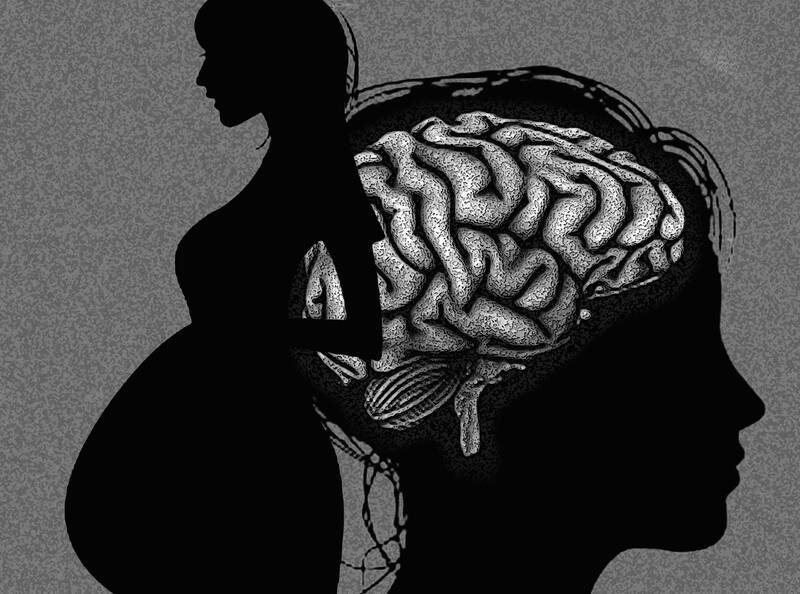“Pregnancy brain” is often treated as a punchline, but a new study shows it is a stunning metamorphosis that scientists are just beginning to grasp — potentially unlocking new knowledge about pregnancy complications and the amazing plasticity of our most complex organ.
The research, published last week in Nature Neuroscience, offers the first detailed look at the incredible transformation of the human brain during pregnancy. It is an ambitious and overdue exploration of the ways that the major life event affects women’s short and long-term health.
“Pregnancy is like a stress test for the body,” says Emily Jacobs, director of University of California (UC) Santa Barbara’s Ann S. Bowers Women’s Brain Health Initiative, and a coauthor of the study. The massive changes include shifts in hormone levels and the immune system, and more work for organs like the heart and kidneys.

Illustration: Constance Chou
However, few details have been known about the changes to the brain. Jacobs points out that less than half of a percent of the 50,000 brain imaging studies published since the 1990s specifically focus on women’s health.
The previous studies we do have, while important first steps in this burgeoning field of maternal brain mapping, only captured images of the brain before and after childbirth (with one recent large study also getting a peek during the third trimester). The UC researchers went much further. Magnetic Resonance Imaging was conducted before conception, every few weeks during gestation, and two years after birth for a total of 26 scans — ultimately offering a more comprehensive picture of the brain’s transformation during and after pregnancy.
GRAY MATTER
“This approach captures subtle neural variations that might otherwise go unnoticed, enhancing our comprehension of brain adaptations during this critical period,” Ann-Marie de Lange, head of FemiLab at Lausanne University Hospital in Switzerland, said in an e-mail.
Indeed, the researchers found what prior research would have missed: A metamorphosis driven by hormonal fluctuations, with some changes in the brain returning to baseline by birth and others persisting for years after. Most strikingly, nearly all parts of the cortex showed a reduction in gray matter, the tissue responsible for processing and interpreting information, commandeering things like movement and memory. That persisted in the years after birth.
That might sound alarming. The part of the brain responsible for processing is … shrinking? Jacobs compares the transformation to Michelangelo sitting before a block of marble. “The underlying beauty is revealed through the art of removal, carefully honing and fine-tuning the material.” In other words, this amazing display of neuroplasticity could potentially represent not a loss of function, but a gain in efficiency as women prepare for parenthood. It is an exercise in cortical refinement that the brain undertakes at a few distinct stages of a woman’s life — adolescence, matrescence and again during menopause.
They also found transient increases in the quality of connections in the brain tissue known as white matter, peaking in the second and third trimester before returning to baseline at birth (a shift previous studies would have missed).
We would need more research to tell us what this metamorphosis means for human behavior. Animal scans have linked certain brain changes to a mother’s sensitivity to smells and sounds from her newborns and maternal behavior like nest building and grooming.
“Obviously, humans are way more complicated,” Jacobs said, adding that parental behavior manifests in partners, grandparents, adoptive parents and many others who did not grow a child in their body.
KNOWLEDGE GAPS
To further their knowledge, the UC team has already captured biweekly snapshots of the brains of seven additional pregnant women and plans to recruit up to 20 people. Eventually, more than 200 first-time mothers would be followed monthly as part of a partnership with researchers in Spain.
The hope is to illuminate changes in the brain during pregnancy across women from many walks of life to help scientists better understand the underlying mechanisms of and risks for conditions like preeclampsia, migraines and postpartum depression. To get at answers, researchers would need to look not only at the anatomical changes in the brain, but study the vascular and functional ones, says Joana Pinto, a neuroimaging expert who leads Oxford’s Maternal Brian Project.
Take pre-eclampsia, a dangerous condition typically marked by soaring blood pressure. All pregnant women experience increased blood flow to the brain during pregnancy, but something goes awry in women with preeclampsia, explains Pinto. Much more research is needed to understand that process and whether the wear and tear on the blood vessels during pregnancy might affect brain health later in life. (Some studies suggest, for example, it could raise the risk of developing dementia.)
Women’s health has been understudied for far too long. That neglect stems in part from erroneous assumptions that studying men’s brains is enough. “Thankfully, there is a growing understanding that these fluctuations play a dynamic role in brain structure and function, and that findings based on male participants do not necessarily apply to women — we are not just smaller versions of men,” says De Lange.
Studies like this one are critical to closing the egregious knowledge gap in the field of neurobiology — and in medicine overall.
Lisa Jarvis is a Bloomberg Opinion columnist covering biotech, health care and the pharmaceutical industry. Previously, she was executive editor of Chemical & Engineering News. This column does not necessarily reflect the opinion of the editorial board or Bloomberg LP and its owners.
When US budget carrier Southwest Airlines last week announced a new partnership with China Airlines, Southwest’s social media were filled with comments from travelers excited by the new opportunity to visit China. Of course, China Airlines is not based in China, but in Taiwan, and the new partnership connects Taiwan Taoyuan International Airport with 30 cities across the US. At a time when China is increasing efforts on all fronts to falsely label Taiwan as “China” in all arenas, Taiwan does itself no favors by having its flagship carrier named China Airlines. The Ministry of Foreign Affairs is eager to jump at
The muting of the line “I’m from Taiwan” (我台灣來欸), sung in Hoklo (commonly known as Taiwanese), during a performance at the closing ceremony of the World Masters Games in New Taipei City on May 31 has sparked a public outcry. The lyric from the well-known song All Eyes on Me (世界都看見) — originally written and performed by Taiwanese hip-hop group Nine One One (玖壹壹) — was muted twice, while the subtitles on the screen showed an alternate line, “we come here together” (阮作伙來欸), which was not sung. The song, performed at the ceremony by a cheerleading group, was the theme

Secretary of State Marco Rubio raised eyebrows recently when he declared the era of American unipolarity over. He described America’s unrivaled dominance of the international system as an anomaly that was created by the collapse of the Soviet Union at the end of the Cold War. Now, he observed, the United States was returning to a more multipolar world where there are great powers in different parts of the planet. He pointed to China and Russia, as well as “rogue states like Iran and North Korea” as examples of countries the United States must contend with. This all begs the question:

Liberals have wasted no time in pointing to Karol Nawrocki’s lack of qualifications for his new job as president of Poland. He has never previously held political office. He won by the narrowest of margins, with 50.9 percent of the vote. However, Nawrocki possesses the one qualification that many national populists value above all other: a taste for physical strength laced with violence. Nawrocki is a former boxer who still likes to go a few rounds. He is also such an enthusiastic soccer supporter that he reportedly got the logos of his two favorite teams — Chelsea and Lechia Gdansk —